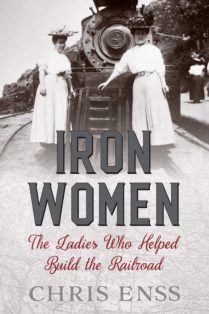Enter now to win a copy of
Iron Women: Ladies Who Helped Build the American Railroad

The Harvey Car Courier Corps will take you away “into the beckoning, foot-loose distances of New Mexico,” reads the Santa Fe Railway brochure on Indian Detours. The brochures were distributed to train travelers crossing the arid Southwest desert in the late 1920s, who were looking for adventure and romance.[i]
Indian Detours were created by the Fred Harvey Company in 1925. The popularity of the automobile and the airplane had created a lull in railroad travel. The Harvey Company introduced the detours in hopes of encouraging the public to journey by train to their next vacation destination. The tours were only available for the Southwest part of the country, from the Grand Canyon to Santa Fe. The specialized tours by car were to divert passengers from the train for one to three days and drive them through the “wilderness panoramas” of northern New Mexico to Indian ruin sites and living pueblos.[ii]
The drivers of the Harvey vehicles, which included Packards, Franklins, Cadillacs, and White Motor Company buses, were always men. The tour guides or “couriers” were always women. Executives at the Harvey Company believed following the business model of the Harvey Girls would assure the success of the Indian Detours.[iii]
The women selected to be members of the Harvey Car Courier Corps spent weeks training for their positions. In order to be qualified tour guides, they were required to know the archaeological, ethnological, cultural, geological, botanical, historical, and legislative makeup of New Mexico. It was necessary that the information they shared with travelers was accurate. The couriers attended lectures and participated in trips along the detour trail. According to the March 12, 1975, edition of the Santa Fe New Mexican, the majority of the Harvey Car Courier Corps members found the work interesting. Aside from teaching school, there were very few interesting jobs for women post World War I. Couriers earned $150 a month, $160 a month if they spoke a foreign language and could communicate with travelers from other countries.[iv]
Among the well-known individuals who took advantage of the Indian Detours was Albert Einstein, John D. Rockefeller, Will Rogers, and Guglielmo Marconi, the inventor of the wireless telegraphy.[v]
The Harvey Couriers were required to dress in Navaho-style costumes while giving the tours. The authentic outfit consisted of velveteen skirt, concha belts, and squash blossom necklaces.[vi]
The tours originated from the Harvey Houses: the Castaneda in Las Vegas, New Mexico; the Alvarado in Albuquerque; the Ortiz in Lamy; and the Navajo in Gallup. The most popular detour trips were to the Painted Desert, the Petrified Forest, and the Indian Pueblos in Taos and Santa Clara. The cost for the tours ranged from $10 to $14 a day.[vii]
The Great Depression brought about the end of the Indian Detours and the Harvey Couriers
[i] Carlsbad Current-Argus, February 10, 1928
[ii]Ibid., https://santafeselection.com/blog/2014/06/21/Indian-detours-now,
[iii] The Santa Fe New Mexican, March 12, 1978
[iv] Ibid.
[v] Ibid.
[vi] https://santafeselection.com/blog/2014/06/21/Indian-detours-now
[vii] Albuquerque Journal, February 6, 1928


